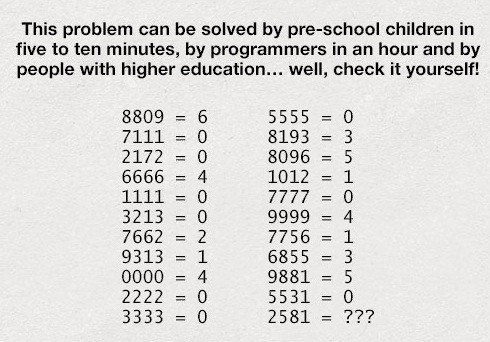
The gizmo in yesterday’s post is a Stroh violin. This is what it sounds like:
The fiddler is Jill Woodhouse, of the Beautiful Music Violin Shop in Lawrence, Kansas.
Trivia that matter

The gizmo in yesterday’s post is a Stroh violin. This is what it sounds like:
The fiddler is Jill Woodhouse, of the Beautiful Music Violin Shop in Lawrence, Kansas.

I’m following four current shows. Three of them — Moyashimon Returns, Dog Days II and Joshiraku — are pleasant entertainments and little more, and I haven’t much to say about them. ((Steven has lots to say about Dog Days.)) The fourth, Jinrui wa Suitai Shimashita, or Humanity Has Declined, is a series unlike other series. Exactly what it is, I’m still not sure. It initially was surrealistic and satirical, but in recent episodes the emphasis has shifted from ridicule to something nearer science fiction as we know it. It remains plenty strange, though. I wonder if there will ever be an explanation for the fairies: are they actually cutesy morlocks, or sucrose-based alien life forms, or what? In any case, beware of fairies bearing bananas.
The ending theme of Jintai, “Yume no Naka no Watashi no Yume,” reminds me strongly of the opening and ending of Azumanga Daioh. There’s a good reason for that. It was written and sung by Masumi Itou, who was half of the Oranges and Lemons duo. She was also part of Heart of Air, of “Blue Flow” fame. (Say “‘Blue Flow’ fame” ten times fast.) There is a transcription of “Yume no etc.” and a link to sheet music here if you’d like to follow the key changes.
Incidentally, the ending theme of Joshiraku, “Nippon Egao Hyakukei,” suits Momoiro Clover Z’s talents and limitations much better than the opening of Mouretsu Pirates, and I would link to a video of it if I could find one on YouTube. It’s the most energetic closing song I’ve heard since Pumpkin Scissors‘ “Mercury Go.”
An interesting observation from Jane in Anchorage:
Our Latin Mass choir here has, counting myself and my husband, three men and eight women. The oldest person in the choir is about 40, or not much older, four of us are in our 20s, and four are teenagers.
In contrast, there is currently no one in the parish choir, that sings at the main English-language Mass of the day, who is under 50.
Nothing special — just plain, ordinary gypsy metal and the like.
Here’s about two week’s worth of accumulated trivia.
I lost patience with radio years ago. The only time I listen nowadays is during storm warnings. Consequently, I never knew the Piano Puzzler existed until Angela at Mommy Bytes recently mentioned its tenth anniversary. Each week, pianist Bruce Adolphe arranges a “familiar” tune in the style of another composer, and the contestant’s task is to identify both the composer and the melody. I can usually identify the composer right off, but naming the tune is often difficult. What makes the segments memorable is Adolphe’s fantastic ingenuity in devising his arrangments, which must be heard to be believed. He does things like combine Schubert with Gershwin, Gershwin with Copland, The Fantasticks with Berg, spirituals with Handel, “Old MacDonald Had a Farm” with Brahms, etc., and makes each combination, no matter how unlikely, work. You can stream the programs or download them here. My favorite so far is the April 6, 2011 program.
My father was a clarinetist in his college marching band. He frequently played recordings of band music at home while I was young, with the result that I grew up allergic to John Philip Sousa. Over the years I’ve acquired some tolerance to the genre — though I’ll never be a fan — enough so that I can enjoy stunts like these.
(Several hotshot young pianists play Horowitz’s transcription on Youtube, if you want to hear it with better sound. To my ears, Volodos is the least unsatisfactory. If you want to understand why it is so difficult to take Lang Lang seriously, this will make it painfully clear.)
*****
I’m sure it’s purely coincidental, but it amuses me that the best-known of all mahou shoujo is clad in red, white and blue.
A young friend had a good day yesterday, placing third in the open division at the Missouri Fiddlers and Country Music Association fiddle contest.
Miscellaneous musical notes:
My financial situation has improved from desperate to merely uncomfortable, and I’ve been able to finally make a few purchases that I’ve had in mind for years. For instance, I now have a grand piano. More precisely, I have a mathematical model of a grand piano in my laptop, Modartt’s Pianoteq. It’s no substitute for the real thing, of course, but I don’t have the space for a full-size grand, let alone the cash. Pianoteq sounds pretty good, and it’s much more “alive” than any sample-based instrument I’ve played. Add a pinch of reverb, and it would take a very sensitive ear to tell that it’s not an actual physical piano in a recording. If you have a velocity-sensitive MIDI keyboard handy, download the demo and try it yourself.
Because it’s not based on samples, the software requires surprisingly little disc space. Pianoteq is only 20 megabytes large. In comparison, Synthology’s Ivory II Italian Grand takes 28 gigabytes, and EastWest’s Bösendorfer gobbles 87. (They also need 7200 RPM disc drives, which means they won’t run on my humble laptop, where I need them. ((On top of that, they both require you to by an “iLok” key, a goddam miserable expletive-deleted dongle, and that is a deal-killer. (Q. What is the purpose of digital rights management? A. To punish the legitimate user.) I daresay that these are wonderful instruments, but I ain’t touching them.))) Physical-modeling synths such as Pianoteq do make heavy demands on the processor, but my laptop handles the load easily.
*****
I’ve been considering finally buying one of the major notation packages, either Finale or Sibelius. I don’t need the full, all-the-bells-and-whistles versions, which is fortunate, because I don’t have the funds. However, the affordable intermediate version of each can be installed on only one computer, which is inconvenient. I think I’ll see how well MuseScore works.
*****
I see that Bakumatsu Kikansetsu Irohanihoheto (did I spell that correctly? Yes) has been licensed. I’m a little surprised. Although I enjoyed the first several episodes, I never did finish watching it, and I don’t recall that it was exceptionally good or particularly popular.
However, it does feature a good Yuki Kajiura opening song.
*****
Josh, who prefers J.K. Rowling to Margaret Atwood, finds echoes of Kierkegaard in Talking Heads.
A few recently-spotted items worth quoting:
Being politically correct does not trump being grammatically correct…please fix.
— Dr. J’s Gothic Literature teacher
But these days the wages of sin is boredom.
Well, I could argue that a proper understanding of punk and its inherent rebellion would have everyone becoming a libertarian or principled conservative …
— Mollie Hemingway (in the comments)
The last is from a thread about the “Weirdest Band You Love.” It’s hard to pick the strangest of my many musical enthusiasms, but the Sons of Rayon might be the most obscure. The inventors of velco tap dancing (fiddler/guitarist Kelly Werts glued velcro hooks on the soles and heels of his shoes and danced on a patch of tightly-woven carpet, which was miced, creating sound when his feet left the platform), the Bill Monroe-meets-Robert Fripp trio was active in Wichita for several years around 1980. They released one cassette, No Velcro, which was one of the first items I digitized when I hooked up my computer to the stereo. Here is perhaps their loveliest song, written and sung by banjoist Paul Elwood and featuring Intergalactic Yodeling Champion Randy Erwin, “UFOs Over New Zealand.”
A little something for math and physics majors, via Fillyjonk.
Here’s Igudesman & Joo & Kremer’s take on the same tune:
Odds and ends:
I didn’t get very far into Haiyore! Nyaruko-san the first time I sampled it. Sticking a fork into a little girl is not amusing, even if the girl is actually Nyarlathotep. However, both Steven and Ken the Brickmuppet found the first two episodes not entirely worthless. So I gritted my teeth, put my feet firmly on the floor, gripped the armrests of my chair, and grimly stuck it out through the rest of the first episode. Well, it is an improvement over the wretched flash shorts of two years ago, and the forking is not quite as offensive. ((Kirika Yumera remains the only person in anime licensed to use the fork as an offensive weapon.)) Still, I found it more irritating than funny, and I doubt that I’ll watch more.
By the way, Howard Phillips Lovecraft for a brief period was a Miss Lonelyhearts, answering questions such as this:
I am Xah’gnui, who has long delved into the annals of subterranean lore, conducting forbidden researches into the unknown, with a view to resurrecting aeon-silent interplanetary necromancer-lizards. Why is it so hard for me to get a date?
(Via Lynn.)
*****
I see there is an “aniblog” tournament underway. The candidates were drawn primarily from AnimeNano, if I’m interpreting the rules correctly. Unfortunately, this leaves out some of the most interesting weblogs that deal with anime. For instance:
All of these are worth a visit.
*****

Allegedly, the more subtle your mind, the more difficult you’ll find this puzzle. I got it in about 30 seconds.
(Via AoSHQ.)
*****
Mahou shoujo anime is pornographic. So is anime set in high schools. In fact, probably every anime produced this century is pure pornography.
(Via Dustbury.)
*****
Quote of the week, sobering thought division:
The greatest legacy of the internet may wind up being Cute Overload.
*****
Quote of the week, anime division:
If I had a daughter, I’d want her to watch this.
(The Brickmuppet on Mouretsu Pirates.)
*****
Memo to Trek Bicycle Corporation: I see that your factory is in Waterloo, Wisconsin. There is a good chance that you can find literate native speakers of English there. Please hire one, and have him write directions for mounting your luggage rack on a bicycle, so customers don’t have to puzzle over the cryptic diagrams that come with the rack. By the way, it would be thoughful to note on the outside of the packaging that installing the rack requires a hacksaw and file, where customers can see it before buying the rack.
While at the bike shop earlier this week, I discovered that Trek bicycles include a line called “Neko.” Surprisingly, there is no suggestion of anything feline on the bike or on the Trek website. The Neko does feature “Women’s disc brakes.”
Johann Sebastian Bach was born 327 years ago today (or on March 31, depending on which calendar you use). To celebrate the occasion, Amazon.com is selling nine hours of his music for 99¢ for a few days. I recognized a few of the performers, such as Joseph Szigeti and Andras Schiff, but most I’m not familiar with. I expect that the Amazon offering is mainly good older recordings and recent recordings by lesser-known artists. It’s probably worth gambling a dollar on.
*****
I know what I want for Christmas:
In the 1970s, Jack Thompson bought a tract of land in the Royal Gardens subdivision on the island of Hawaii and began building a cedar home there. He finished it in 1983. As he installed the second-story windows, he noticed a orange glow on the panes. The light came from the lava fountains that heralded the eruption of Kilauea, which continues to this day. Over the years, lava flows took out all his neighbors’ homes, one by one, until only Thompson’s was left. This month, a vigorous flow found his house, leaving little beyond a satellite dish embedded in six feet of basalt.
There are three pages to the score for Terry Riley‘s In C. Two of the pages are performance directions; the actual music all fits on a single page. It consists of 53 numbered phrases ranging in length from two sixteenth notes to 32 quarter notes. The performer plays each phrase in sequence, repeating it as many times as he wishes, before moving on to the next phrase. Riley suggests a group of about 35 musicians. Performances normally run between 45 and 90 minutes, according to Riley.
Although I’ve occasionally read about In C — it’s perhaps the first example of musical “minimalism” — and I’ve looked at the score, I’ve never actually heard it. A few days ago, I heard Riley’s A Rainbow in Curved Air for the first time in decades (not counting its use in The Hitchhiker’s Guide to the Galaxy radio program).1 It was more engaging than I remembered, and it occurred to be that I didn’t need to round up 35 musical friends to get an idea of what In C sounded like. I could just launch Logic and sequence as many voices as I wanted. Which I did.
This is a stripped-down, streamlined version. It’s a little over eleven minutes long, and there are only five voices — six, if you count the “pulse.” I didn’t plan it out beyond shifting loops nicely out of phase. It probably doesn’t truly represent what In C should be, but it might suggest how the music works. I likely will revise and expand this arrangement sometime soon. You can download the score here if you want to follow along or organize your own performances. There’s also a 50-minute orchestral “realization” of In C at the site — unfortunately, using what sounds like an undistinguished general midi soundset.
You can imagine Mikuru Asahina playing the repeated high C eighth notes if you wish. Or Zooey Deschanel.
Update: Uploaded a new version with additional voices and a few tweaks.
Visitors here, reading posts such as this, might assume I listen only to Japanese music. That’s not quite true. I listen also to Finnish music. For instance, Gjallarhorn: